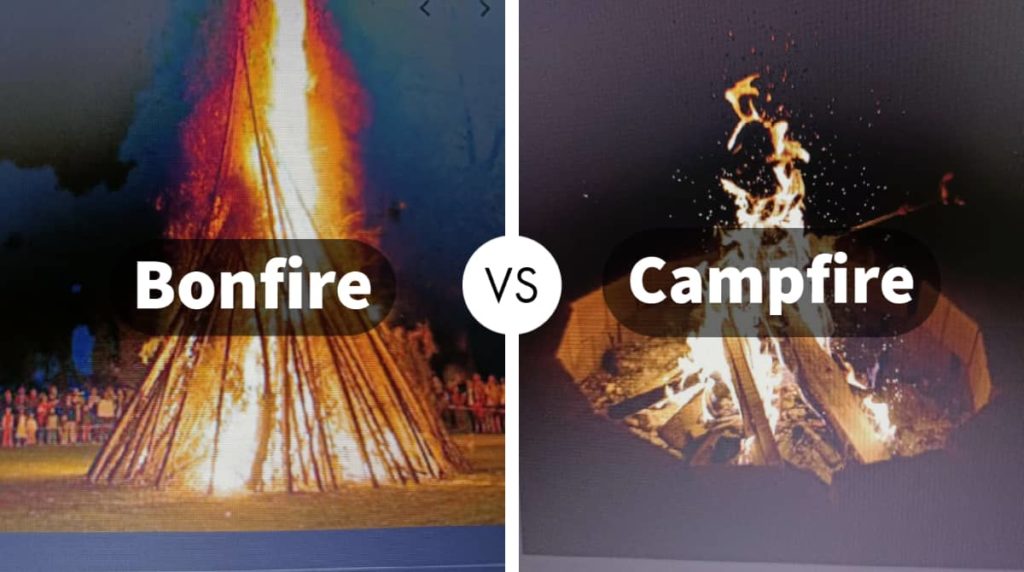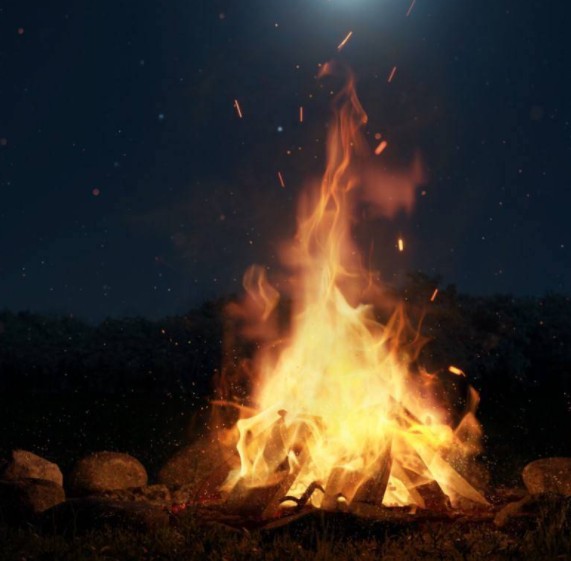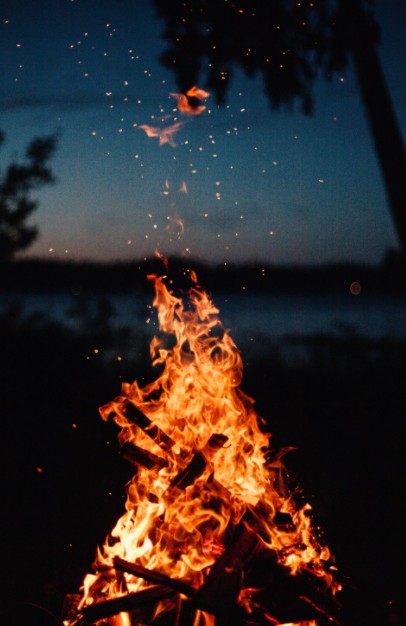Bonfires and Campfires are quite hot term among the campers, but there are very few people who actually know the real differences among them. Due to that lack of knowledge even now many outdoor enthusiasts use these terms interchangeably.
So it’s better to address this bonfire vs campfire debate here, so that you can know them better. They have lots of differences, but in short that can be defined in 3 aspects: size, purpose & building technique.

Bonfires are by default large in nature, and best suited for larger parties or celebrations with loud music, but Campfires are pretty small in size, which can easily be contained in a fire pit to provide warmth, get rid of small insects/animals or make foods.
So if you’re planning for a party with a group of 20 people or more, then you should opt for a bonfire. But if you wanna spend a calm night with alone or just with your best buddies, then campfire is the one that you should choose.
What is a Bonfire?
Mainly started for a ritual, Bonfire is a massive pit of fire made with long and thick logs stacked against one another to form a giant fire, obviously in a controlled way. The reason for starting a bonfire is mainly tradition or rituals, but nowadays it is also being used for larger celebrations or parties.
As we all know in ancient days, humans used to worship the main disastrous aspects of nature like rain, water, earth and fire, assuming that worshiping them will prevent them from harming mankind.

All the rituals surrounding the fire are mostly originated by that. As a matter of fact, fire is believed to be a purifier. We can see many rituals that are associated with a bonfire, especially in the Asian countries like India.
Bonfires can also be helpful for disposing waste materials such as old scrap of furniture or heap of old wooden appliances that are not needed anymore. It can also work as a signaling device to help people locate an event easily.
How to Build a Bonfire?
Bonfires are not that difficult to build, but we must consider some additional factors while doing one. First and foremost, it needs to be set up in a larger area preferably in an open field which is far away from any trees, brush, or flammable objects in order to nullify the chance of any casualties.
You may also require a special permit to build a bonfire. In fact I would suggest to always take prior permission from the local authorities to stay on the safer side from any future mishaps. It is also advisable to have fire extinguishers on hand as a safety measures.
You need to understand that bonfires are not meant for cooking food, rather they are used for burning. In fact, in the ancient times, bonfires were actually part of a religious activity designed to offer sacrifices.
Bonfires generally create a lot more heat than campfires. That’s why it is difficult to sit near them and chill. They also require a lot more firewood like wood pallets or large logs. If you don’t feed the fire generously, it won’t work.
The Origin of Bonfire
Bonfire is the combination of two different words, that are “bone” and “fire”. As per some historians, this term was originated from a special type of festival held by Celts long time ago. They used to burn a lot of bones to keep the evil spirits away.
Even if you don’t wanna believe that, you can’t deny the fact that bonfires are tied with many different occasions or religious festivals across the world. In short, it does have spiritual significance.
But in recent times, we do use bonfires for special parties or events to chill with a large group of people with loud music in order to celebrate a big event.
Advantages
✅ As stated before the bonfire is built in a massive place so there are some activities that can be arranged surrounding it.
✅ Useful for larger events or celebrations
✅ Because of its massive size, no one can sit near it, therefore causing less danger and chances of fire burning.
Disadvantages
❌ It needs a lot of space to arrange and sometimes permission to build a fire that huge.
❌ Bonfire needs more resources to kindle.
❌ Being a huge pit of fire, building a bonfire is an offense if proper rules of building a bonfire are not followed.
❌ Difficult to contain, and can create adverse situation if left unattended.
What is a Campfire?
Campfire is a smaller mass of fire that is built mainly for campsites to prevent insect infestation, to provide light for visibility, to cook small meals or to keep oneself warm.
Unlike bonfires, campfires are mostly built for necessity and sometimes, pleasure. One can sit comfortably near a campfire which is pleasurable and sufficient to be nicely heated.

Campfires can be arranged in a small or medium pit. Unlike bonfires, campfires do not need a large ground or fairly a permission to build; it can be built anywhere.
How to Build a Campfire?
Campfire is very easy to build, and anyone can do it. But that doesn’t mean we should act careless while doing so. It’s very important to take all the safety measures before building a campfire. It should be set up away from trees, brush and tents to avoid any unnecessary circumstances.
I have been to numerous campsites, and majority of them have prebuilt fire rings or fire pits. But here I will tell you how to quickly build a fire ring if your campsite doesn’t have that facility.
After building the fire ring, our next goal is to build the campfire. You need to have at least 4 basic materials to start it.
It’s not a herculean task to keep the campfire going. You just need to perform the following tasks efficiently:
Please Note: It is important to completely extinguish the campfire before leaving the place. Though it is small in size, it can also be a fatal if left unattended for a longer period of time.
The Origin of Campfire
As per a new study the first ever campfire was built roughly 1.6 million years ago somewhere in South Africa. So it’s not a twentieth century thing. But it is evident that campfire is gaining momentum especially because it’s highly popular among the millennials.
Advantages
✅ Campfires can help cooking food or heating water.
✅ It is a source of light and heat to the picnickers
✅ It acts as an insect and predator deterrent
✅ Sitting beside a campfire relaxes the mind and subsides stress.
✅ It can also be used as a signal as it can be seen from far away.
Disadvantages
❌ Any fire unattended can lead to an unwanted disaster.
❌ Sitting near a fire for a long time, can increase the amount of carbon inhalation, which is harmful to inner organs like lungs.
❌ Can’t be used in larger parties.
Bonfire vs Campfire: Safety Measures & More
You must take the weather and air quality reports into consideration before building a campfire or a bonfire. Here I will be talking three most important points:
There are other safety factors as well that you should be aware of:
Frequently Asked Questions (FAQs)
Is a fire pit considered an open fire?
Yes it does in majority of the cases. But there are some city specific rules and regulations as well. So it’s better to check with your local authorities to get the accurate answer.
How long does a bonfire last?
There is a very popular 1/2 inch rule. It simply states that for every 1/2 inch of firewood or fuelwood, your fire will burn for about sixty odd minutes. However, some wood burns faster than the others. So this general thumb rule doesn’t apply all the time.
Should you pour water on fire pit?
Yes you can. You should use a bucket full of water on the ashes to completely extinguish the fire. It works like a charm.
Conclusion
I hope your search for bonfire vs campfire will end here. To conclude I will say bonfires are for larger celebrations, events or rituals, where campfire are for camping, cooking etc. Though both the types are actually fire and source of hit, they are different than each other in terms of size, technique and purpose.
In the end, it can be said that both ways of fire have their own advantages, but without proper safety measures, even an innocent tint of fire can become a massive aggressive all-devouring giant.
Both the types are now part and parcel of our lives, so it’s good to understand the basic difference between a campfire and a bonfire. If you still have any doubts, feel free to ask in the comments below.
- Freediving Fins vs Scuba Fins: A Detailed Comparison - February 21, 2022
- How to Use Hammock Straps (A Step by Step Guide) - February 21, 2022
- 8 Best Places to Fish in Ohio (With Complete Details) - February 20, 2022
